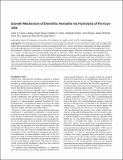Files in this item
Growth mechanism of dendritic hematite via hydrolysis of ferricyanide
Item metadata
| dc.contributor.author | Green, Alice | |
| dc.contributor.author | Chiang, Chang-Yang | |
| dc.contributor.author | Greer, Heather Frances | |
| dc.contributor.author | Waller, Ashleigh | |
| dc.contributor.author | Ruszin, Aron | |
| dc.contributor.author | Webster, James | |
| dc.contributor.author | Niu, Ziyin | |
| dc.contributor.author | Self, Katherine | |
| dc.contributor.author | Zhou, Wuzong | |
| dc.date.accessioned | 2018-01-04T00:32:06Z | |
| dc.date.available | 2018-01-04T00:32:06Z | |
| dc.date.issued | 2017-02-01 | |
| dc.identifier | 248865936 | |
| dc.identifier | c5c9ea4d-39f0-4d1f-b78a-9d2fe7a0ab91 | |
| dc.identifier | 85011372921 | |
| dc.identifier | 000393354100045 | |
| dc.identifier.citation | Green , A , Chiang , C-Y , Greer , H F , Waller , A , Ruszin , A , Webster , J , Niu , Z , Self , K & Zhou , W 2017 , ' Growth mechanism of dendritic hematite via hydrolysis of ferricyanide ' , Crystal Growth & Design , vol. 17 , no. 2 , pp. 800-808 . https://doi.org/10.1021/acs.cgd.6b01655 | en |
| dc.identifier.issn | 1528-7483 | |
| dc.identifier.other | ORCID: /0000-0001-9752-7076/work/58054989 | |
| dc.identifier.uri | https://hdl.handle.net/10023/12421 | |
| dc.description | W.Z. thanks EPSRC for financial support to purchase the FEG SEM (EP/F019580/1). | en |
| dc.description.abstract | The detailed process of the hydrolysis of ferricyanide into dendritic α-Fe2O3 (hematite) crystals with snowflake-like, feather-like and leaf-like morphologies has been investigated. [Fe(CN)6]3– anions were found to polymerize into large, disordered soft matter aggregates at an early stage. The nucleation of hematite crystals took place near the surface of these aggregates via further hydrolysis. After the crystals grew to a certain size, branches started to appear. When the concentration of ferricyanide was low (i.e. 2 mM to 3.8 mM), growth was preferentially along the six equivalent <112̅0> directions, resulting in a flat snowflake-like shape, while high concentrations (i.e. 9 mM to 500 mM) of ferricyanide led to the growth of selective directions along the <101̅1> zone axes, forming a feather-like or leaf-like morphology. Highly selective adsorption and surface hydrolysis of [Fe(CN)6]3– anions on α-Fe2O3 crystals was found to be a crucial process in the formation of these novel morphologies. It was found that the polymeri- sation of ferricyanide led to a reduction of pH value and that the formation of Fe2O3 increased pH value. The pH value of the solution at the point when the branches start to grow can significantly affect the distribution of Lewis acidic sites on different surfaces and, therefore, change the growth direction. The newly established mechanism is complementary to the classical theories of crystal growth. | |
| dc.format.extent | 1185481 | |
| dc.language.iso | eng | |
| dc.relation.ispartof | Crystal Growth & Design | en |
| dc.subject | QD Chemistry | en |
| dc.subject | NDAS | en |
| dc.subject.lcc | QD | en |
| dc.title | Growth mechanism of dendritic hematite via hydrolysis of ferricyanide | en |
| dc.type | Journal article | en |
| dc.contributor.sponsor | EPSRC | en |
| dc.contributor.institution | University of St Andrews. School of Chemistry | en |
| dc.contributor.institution | University of St Andrews. EaSTCHEM | en |
| dc.identifier.doi | https://doi.org/10.1021/acs.cgd.6b01655 | |
| dc.description.status | Peer reviewed | en |
| dc.date.embargoedUntil | 2018-01-03 | |
| dc.identifier.url | http://pubs.acs.org/doi/suppl/10.1021/acs.cgd.6b01655 | en |
| dc.identifier.grantnumber | EP/F019580/1 | en |
This item appears in the following Collection(s)
Items in the St Andrews Research Repository are protected by copyright, with all rights reserved, unless otherwise indicated.

